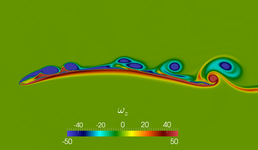Towards biologically-inspired active-compliant-wing micro-air-vehicles
Despite a good knowledge of the physiology of bats and birds, engineering applications with active dynamic wing compliance capability are currently few and far between. Recent advances in development of electroactive materials together with high-fidelity numerical/experimental methods provide a foundation to develop biologically-inspired dynamically-active wings that can achieve "on-demand" aerodynamic performance. However this requires first to develop a thorough understanding of the dynamic coupling between the electro-mechanical structure of the membrane wing and its unsteady aerodynamics. In this collaborative initiative between the University of Southampton and Imperial College London, we are developing an integrated research programme that carries out high-fidelity experiments and computations to achieve a fundamental understanding of the dynamics of aero-electro-mechanical coupling in dynamically-actuated compliant wings. The goal is to utilise our understanding and devise control strategies that use integral actuation schemes to improve aerodynamic performance of membrane wings. The long-term goal of this project is to enable the use of soft robotics technology to build integrally-actuated wings for Micro Air Vehicles (MAV) that mimic the dynamic shape control capabilities of natural flyers.
Categories
Physical Systems and Engineering simulation: CFD, fluid structure interaction
Algorithms and computational methods: Finite differences, Multi-physics
Simulation software: HiPSTAR
Visualisation and data handling software: h5py, HDF5, ParaView, TecPlot
Programming languages and libraries: Fortran, MPI, OpenMP, Python
Computational platforms: ARCHER, Iridis
Transdisciplinary tags: HPC, Scientific Computing
